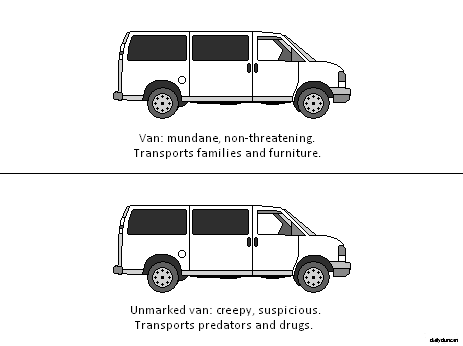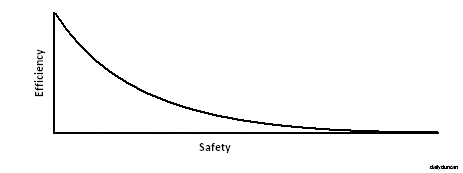Tag: vehicles
Terminal Velocity
In the year 2000 there were over six million motor vehicle accidents in the United States, resulting in 41,945 human fatalities. In that same year an estimated 247,000 deer were maimed or killed in motor vehicle collisions, and it’s likely that other species, such as birds, suffered even greater losses. Driving is undeniably dangerous.
Many of these accidents were likely caused by intoxication or carelessness, but piloting a 1,000 kg metal box at speeds exceeding 100 km/h is inherently hazardous. In an effort to mitigate the number of vehicle collisions, some groups are lobbying for reduced speed limits, especially in residential and high-traffic areas. Their premise that slower vehicles will produce fewer collisions couldn’t be less inaccurate.
It’s obvious to most that slower vehicles are safer, since the force of impact is diminished and the window for driver reaction is expanded. Objects with no velocity are the easiest to avoid since they rarely crash into things. Unfortunately, getting motorists to slow down is not as simple as a mere adjustment in signage.
A report by the Turner-Fairbank Highway Research Center concluded that neither lowering nor raising speed limits by up to 24 km/h had a significant effect on motorist speed. The report’s conclusion states, “…motorists do not alter their speed to conform to speed limits they perceive as unreasonable for prevailing conditions.” But even if drivers did obey the new speed limits, a more challenging question must be answered: how many lives are we willing to sacrifice?
Most groups advocating lower speed limits are requesting that they be reduced by 10 or 20 km/h, but slower vehicles would still produce some collisions, injuries and deaths. So how many fatalities are we willing to accept as a natural consequence? This is a very difficult question to answer, and it applies to many areas beyond that of motor vehicles.
In every industry there are deaths, injuries or accidents of some kind. Rules are created, precautions are taken and laws are passed to reduce these incidents, but they aren’t really aimed at reducing the number of incidents to zero. This is because safety is inversely proportional to efficiency.
Imposing health and safety practices on an industry will inevitably make it less efficient. Conversely, an industry operating without any concern for safety would likely be very efficient, that is, until its workforce is deceased or debilitated.
Some concerned individuals feel a moral obligation to avoid purchasing products from companies that exploit people, animals or the environment, but again, how much is too much? Let’s look at some examples of absolute positions often taken on subjects that are not absolute.
Many people hold a negative view of oil companies because of the environmental damage they inflict, so they ride a bicycle or take public transit. But almost all the products they buy are transported by fuel-burning freight and constructed with oil-based synthetic materials.
Some individuals choose not to eat meat so that animals might be spared unnatural suffering and an early death, but many animals are killed by farming machinery during the harvest of crops and even more are displaced by agricultural properties. And, of course, they are not concerned with the number of insects that are crushed beneath their feet every day, since bugs do not hold a high animal value.
The idea that moral issues are not as dry and cut as we might like can make us feel overwhelmed and impotent. When we realize that no person, organization or action is purely good or evil, we can succumb to what is known as the grey escape – an apathetic exit to a moral predicament. The grey escape is the perception that when an issue is complex or its answer is not easily reached, the solution must be either nonexistent or unworthy of investigation. People who subscribe to this line of thinking are often too concerned with entertainment, success and pleasure to bother the moral and abstract. “Because the matter is grey,” they say, “it deserves not the time of day.”
Grey things are the most important.
MOV
Commuters are often tempted to violate traffic law to hasten their travel, especially when caught in the teeming thicket of rush hour on a highway. A popular method for averting this petroleum-powered prison is to infiltrate the HOV (high-occupancy vehicle) lane. Obviously, risking an expensive speeding ticket to save some time is not wise, but in moments of extreme emotion, unwise choices can be very appealing. However, we are not here to discuss the viability of criminal behavior in extreme situations; we are here to dissect the term high-occupancy.
First, let us define the form and function of the HOV lane. An HOV lane is a traffic lane reserved for vehicles carrying two or more passengers. They are usually found on saturated highways leading into and outof urban areas, and are often enticingly vacant. The HOV lane’s job is obvious: to encourage drivers to carpool by offering them an exclusive supplementary lane. What is difficult to understand is why a vehicle with only two people in it is considered high-occupancy.
It would be a colossal exaggeration to regard any vehicle containing two people to be highly occupied. After all, is two really a high number? It’s the second lowest possible number of passengers. If having two passengers designates a vehicle as high-occupancy, then a vehicle with one passenger must be low-occupancy. This is known as a binary logic system, and it only allows for either a high or low state. But, as we know, the world is not black and white, often offering complicated variation and exception, not rigid classification. What about vehicles carrying synthetic beings? What about a bus bus which has just dropped off or is picking up a multitude of passengers? What about vehicles carrying children? What about all the things that you said we were to gain?
Apparently there is no distinction made between a parent taking their child along on an errand and a Greyhound full of transients headed into the city. According to traffic law, these vehicles are equally occupied. We should acknowledge and appreciate the unique contributions of each vehicle’s occupation, defining additional states of vehicle occupancy in collaboration with new occupancy-specific lanes. A good start would be creating an MOV lane.
Brotherhood of Nod
In the daily grind of traffic, there is a peculiar occurrence which many have witnessed but few understand. Those who have driven any sort of atypical vehicle, like a motorcycle, hot rod or commercial truck, know it well: the nod.
The nod is a momentary expression shared between two individuals driving vehicles that are similar in size, shape and wheel count. The nod usually occurs just before the two drivers pass each other while traveling in opposing directions. Once the drivers notice each other, in that moment, without any prior relationship or communication, a kinship is shared. As the machines pass, the drivers acknowledge each other with a subtle physical gesture. The gesture is often a slight nod, but it can also take the form of a tip of the hat or a wave (partial or full-fingered). This brief moment of comradery may seem like a shallow, compulsory custom, and it is.
After all, what could two motorcycle-riding strangers have in common with each other, other than a fondness for two-wheeled automobility? What secret knowledge could be shared between truckers, aside from a common vocation? Surely all who drive similar vehicles or work in similar industries needn’t nod at every encounter. But if the requirements for this practice are so minimal, then we should nod to our coworkers, family members, friends, schoolmates, we should nod to those who look like us, dress like us, are a similar age as us, we should nod to those who enjoy similar activities as us, eat the same food as us and think the same thoughts as us.
And why should we only nod while driving? It would make more sense to acknowledge others no matter where we are or what we’re doing. However, nodding at every opportunity to everyone with whom we share something in common would obviously be irritating and impractical. But if the nod is so clearly meaningless when expressed in such circumstances, then what meaning could it possibly have in its current state? If we could sum up this expression in a single statement, it would probably be this:
We are driving similar vehicles.
The next time someone gives you the nod, imagine that phrase and keep your head steady and hands firmly fastened to the wheel.

